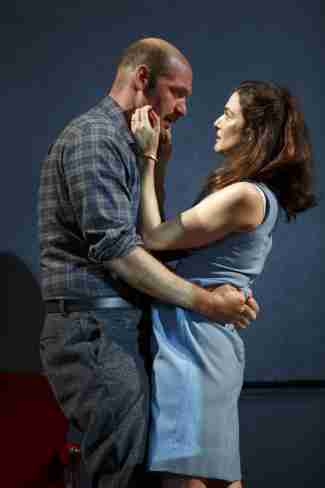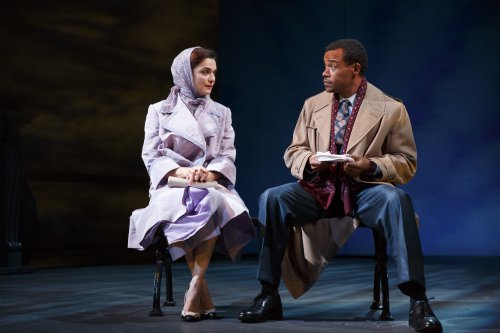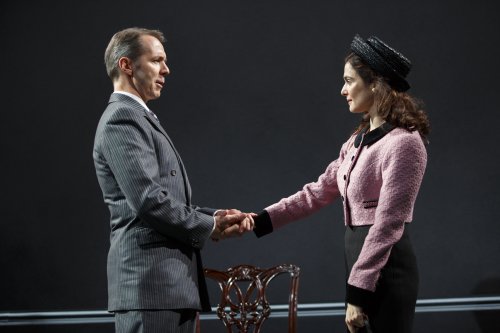Plenty
The return of David Hare’s “Plenty” brings film stars Rachel Weisz and Corey Stoll to the stage of the Public Theater in a David Leveaux production.

Corey Stoll and Rachel Weisz in a scene from The Public Theater’s revival of David Hare’s “Plenty” (Photo credit: Joan Marcus)
[avatar user=”Victor Gluck” size=”96″ align=”left” ] Victor Gluck, Editor-in-Chief[/avatar]According to British playwright David Hare describing the genesis of his seminal 1978 play, Plenty, “I was moved to write the play for two reasons. First, I felt very strongly that women’s experience was missing from accounts of the official history of the period. But secondly, I had read that the marriages of 75% of the female agents for the Secret Operations Executives had ended in divorce. It seemed that their work in the war had left them either with memories or expectations which made it very hard for them to settle back into civilian life.”
Kate Nelligan’s performance as the heroine Susan Traherne in the original production of Plenty was described as a force of nature when the play reached the Public Theater in 1982 under the direction of the author and confirmed her status as an international star. Now the Public has mounted the first New York revival of the play with film stars Rachel Weisz and Corey Stoll. The script hasn’t changed but the play seems to have diminished in power over the intervening years.
The title refers to the “peace and plenty” that idealistic young Englishwoman Susan expects after the conclusion of World War II. After a stint in the British secret service as a courier in France during the Nazi occupation, we see her return to London and attempt to pick up her life. Unfortunately, either because civilian life is too tame or she is infuriated by the hypocrisy of post-war social and political events, she cannot adjust to the life she is offered.

Rachel Weisz and LeRoy McClain in a scene from The Public Theater’s revival David Hare’s “Plenty” (Photo credit: Joan Marcus)
We see her at work and at play on a trip to Brussels where she meets minor diplomat Raymond Brock who she will later marry, looking to find a father for a child in the early 1950’s, her life as a political hostess as Mrs. Brock, and her disappointment with her marriage and conventional life by the early 1960’s. Along the way, Susan has several mental breakdowns that lead to her performing a “sort of psychiatric cabaret” when she is most infuriated by how things are going.
Spanning the post-war period 1944 – 1962, the play has an unusual structure. The first scene is the penultimate scene in 1962 and the last scene is chronologically the next to last scene set in 1944. In between, the scenes take place in chronological order. The only signposts for the audience are references to events of the time. Unfortunately, such British landmarks as the Festival of Britain and the Suez Crisis are little known to Americans today so that the time sequence will become challenging for the majority of New York audiences.
In his Broadway productions, David Leveaux has often used a strong directorial concept such as his Chekhovian Fiddler on the Roof and his interracial Romeo and Juliet which did not work for all theatergoers. Here he seems to have decided that Susan finds life in Britain gray on her return and all of the sets by Mike Britton other than the final one (ironically suggesting the hope of the post-war generation) are made up of gray walls. As a result, none of them have any atmosphere aside from all resembling each other. It is left to the costumes by Jess Goldstein to give clues to the year of each scene which they sometimes do, and sometimes not.

Paul Niebanck and Rachel Weisz in a scene from The Public Theater’s revival David Hare’s “Plenty” (Photo credit: Joan Marcus)
While Academy Award winner Rachel Weisz is a beautiful and talented actress, she can’t keep Susan from being unsympathetic, egotistical and self-serving. As directed by Leveaux, instead of being the heroine who sees what the others don’t, she is someone you don’t root for as she spirals further and further towards madness. She appears as a loose cannon and it becomes more and more obvious that she is destroying her husband’s career in a field she detests – without her offering any alternatives, just criticism. Except for Byron Jennings as Raymond’s high level boss, diplomat Leonard Darwin, in a climactic scene that ends the first act, the other actors mostly playing Englishmen and women observe such a stiff upper lip that the temperature of the play remains very cool.
As the man that Susan eventually marries and then loses respect for, Corey Stoll gives a sturdy, solid performance as an efficient minor diplomat who does not have the brilliance needed to be placed in a position of power. He is excellent at demonstrating that he loves Susan unconditionally even as she drifts away from him. As Susan’s bohemian friend Alice Park who continually reinvents herself, television star Emily Bergl is a colorful character but fails to make the role her own. Jennings’ explosive last scene reveals the seething rage below the seemingly impregnable exterior. LeRoy McClain makes a forceful appearance as a Cockney man outside of Susan’s circle with whom she considers having an affair. In his one scene, Paul Niebanck as head of personnel in the foreign office is a striking presence. The other actors in this large cast tend to be so low key as to not make much impression excerpt as foils for Susan.
In the last scene of the first act, halfway through the 1950’s, Susan exclaims, “Everything is up for grabs. At last. We will see some changes made.” Unfortunately, while Plenty hints at the possibility of a change that did not occur, we never feel that Susan Traherne as played by Rachel Weisz would be capable of being part of that change. As a result, this revival of David Hare’s iconic play about post-war Britain ends up feeling very unsatisfactory.
Plenty (extended through December 1, 2016)
Public Theater
Newman Theater, 425 Lafayette Street, in Manhattan
For tickets, call 212-967-7555 or visit http://www.publictheater.org
Running time: two hours and 30 minutes with one intermission






Leave a comment